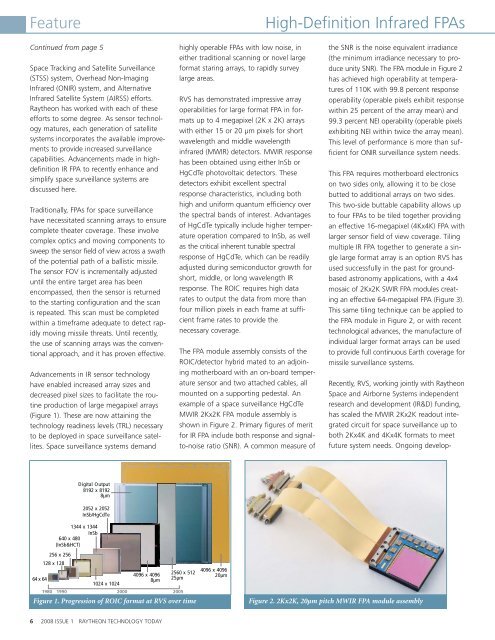Technology Today issue 1 2008 - Raytheon
Technology Today issue 1 2008 - Raytheon
Technology Today issue 1 2008 - Raytheon
Create successful ePaper yourself
Turn your PDF publications into a flip-book with our unique Google optimized e-Paper software.
Feature<br />
Continued from page 5<br />
Space Tracking and Satellite Surveillance<br />
(STSS) system, Overhead Non-Imaging<br />
Infrared (ONIR) system, and Alternative<br />
Infrared Satellite System (AIRSS) efforts.<br />
<strong>Raytheon</strong> has worked with each of these<br />
efforts to some degree. As sensor technology<br />
matures, each generation of satellite<br />
systems incorporates the available improvements<br />
to provide increased surveillance<br />
capabilities. Advancements made in highdefinition<br />
IR FPA to recently enhance and<br />
simplify space surveillance systems are<br />
discussed here.<br />
Traditionally, FPAs for space surveillance<br />
have necessitated scanning arrays to ensure<br />
complete theater coverage. These involve<br />
complex optics and moving components to<br />
sweep the sensor field of view across a swath<br />
of the potential path of a ballistic missile.<br />
The sensor FOV is incrementally adjusted<br />
until the entire target area has been<br />
encompassed, then the sensor is returned<br />
to the starting configuration and the scan<br />
is repeated. This scan must be completed<br />
within a timeframe adequate to detect rapidly<br />
moving missile threats. Until recently,<br />
the use of scanning arrays was the conventional<br />
approach, and it has proven effective.<br />
Advancements in IR sensor technology<br />
have enabled increased array sizes and<br />
decreased pixel sizes to facilitate the routine<br />
production of large megapixel arrays<br />
(Figure 1). These are now attaining the<br />
technology readiness levels (TRL) necessary<br />
to be deployed in space surveillance satellites.<br />
Space surveillance systems demand<br />
64 x 64<br />
256 x 256<br />
128 x 128<br />
Digital Output<br />
8192 x 8192<br />
8µm<br />
2052 x 2052<br />
InSb/HgCdTe<br />
1344 x 1344<br />
InSb<br />
640 x 480<br />
(InSb&HCT)<br />
1024 x 1024<br />
4096 x 4096<br />
8µm<br />
1980 1990 2000 2005<br />
6 <strong>2008</strong> ISSUE 1 RAYTHEON TECHNOLOGY TODAY<br />
highly operable FPAs with low noise, in<br />
either traditional scanning or novel large<br />
format staring arrays, to rapidly survey<br />
large areas.<br />
RVS has demonstrated impressive array<br />
operabilities for large format FPA in formats<br />
up to 4 megapixel (2K x 2K) arrays<br />
with either 15 or 20 µm pixels for short<br />
wavelength and middle wavelength<br />
infrared (MWIR) detectors. MWIR response<br />
has been obtained using either InSb or<br />
HgCdTe photovoltaic detectors. These<br />
detectors exhibit excellent spectral<br />
response characteristics, including both<br />
high and uniform quantum efficiency over<br />
the spectral bands of interest. Advantages<br />
of HgCdTe typically include higher temperature<br />
operation compared to InSb, as well<br />
as the critical inherent tunable spectral<br />
response of HgCdTe, which can be readily<br />
adjusted during semiconductor growth for<br />
short, middle, or long wavelength IR<br />
response. The ROIC requires high data<br />
rates to output the data from more than<br />
four million pixels in each frame at sufficient<br />
frame rates to provide the<br />
necessary coverage.<br />
The FPA module assembly consists of the<br />
ROIC/detector hybrid mated to an adjoining<br />
motherboard with an on-board temperature<br />
sensor and two attached cables, all<br />
mounted on a supporting pedestal. An<br />
example of a space surveillance HgCdTe<br />
MWIR 2Kx2K FPA module assembly is<br />
shown in Figure 2. Primary figures of merit<br />
for IR FPA include both response and signalto-noise<br />
ratio (SNR). A common measure of<br />
2560 x 512<br />
25µm<br />
4096 x 4096<br />
20µm<br />
High-Definition Infrared FPAs<br />
the SNR is the noise equivalent irradiance<br />
(the minimum irradiance necessary to produce<br />
unity SNR). The FPA module in Figure 2<br />
has achieved high operability at temperatures<br />
of 110K with 99.8 percent response<br />
operability (operable pixels exhibit response<br />
within 25 percent of the array mean) and<br />
99.3 percent NEI operability (operable pixels<br />
exhibiting NEI within twice the array mean).<br />
This level of performance is more than sufficient<br />
for ONIR surveillance system needs.<br />
This FPA requires motherboard electronics<br />
on two sides only, allowing it to be close<br />
butted to additional arrays on two sides.<br />
This two-side buttable capability allows up<br />
to four FPAs to be tiled together providing<br />
an effective 16-megapixel (4Kx4K) FPA with<br />
larger sensor field of view coverage. Tiling<br />
multiple IR FPA together to generate a single<br />
large format array is an option RVS has<br />
used successfully in the past for groundbased<br />
astronomy applications, with a 4x4<br />
mosaic of 2Kx2K SWIR FPA modules creating<br />
an effective 64-megapixel FPA (Figure 3).<br />
This same tiling technique can be applied to<br />
the FPA module in Figure 2, or with recent<br />
technological advances, the manufacture of<br />
individual larger format arrays can be used<br />
to provide full continuous Earth coverage for<br />
missile surveillance systems.<br />
Recently, RVS, working jointly with <strong>Raytheon</strong><br />
Space and Airborne Systems independent<br />
research and development (IR&D) funding,<br />
has scaled the MWIR 2Kx2K readout integrated<br />
circuit for space surveillance up to<br />
both 2Kx4K and 4Kx4K formats to meet<br />
future system needs. Ongoing develop-<br />
Figure 1. Progression of ROIC format at RVS over time Figure 2. 2Kx2K, 20µm pitch MWIR FPA module assembly

















